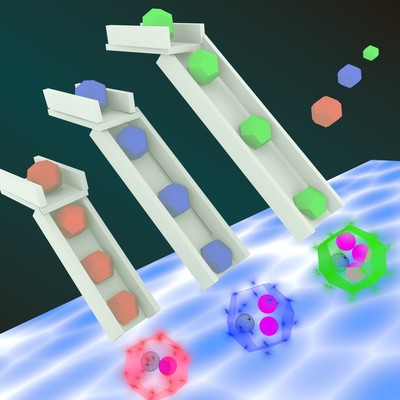A new optical dimension in nanophotonics
Macquarie University researchers, leading an international collaboration, have invented of a new generation of nanocrystals called ‘τ-Dots’. These can be coded in the newly discovered optical dimension of time in addition to colours; that is, their luminescence lifetimes (τ) can be engineered and assigned to a single nanoparticle. The study has been published in the journal Nature Photonics.
The researchers note, “Optical multiplexing plays an important role in applications such as optical data storage, document security, molecular probes and bead assays for personalised medicine”, but that “conventional fluorescent colour coding is limited by spectral overlap and background interference, restricting the number of distinguishable identities.”
According to lead researcher Yiqing Lu, the revelation of the extra dimension “offers an exponential boost in the total number of potential combinations, which can be used for multiple medical tasks or diagnoses simultaneously”. It is said to offer untapped clinical potential in non-invasive cancer diagnostic kits, rapid pathogen screening for acute infection and invisible coding for identification of authentic pharmaceuticals.

Lead researcher and ARC Future Fellow Dr Dayong Jin explained, “These nanocrystals can form combination codes, like barcodes, to form a vast library of distinguishable molecular probes, which can be used for complex diagnostics. Screening tests can more quickly and accurately identify the cause of infection, residue cancers at an early stage and locate the specific molecular targets for targeted drug therapies.”
Co-author Professor J Paul Robinson, from Purdue University, said, “This toolset is really a paradigm shift for identifying rare events in high-noise environments typical in biological systems such as cancer detection, high-throughput screening and also in the biodetection domain.”
Lu said the τ-Dots also have application in improving the storage capacity and security of data, laying the τ-Dots’ lifetimes in a way that “enables higher-density storage than was previously possible” and “codifying the τ-Dots until they are essentially impossible to crack”.
He added that the τ-Dots can be applied to any surface in order to mark it or leave a secret message, “which will only be revealed by a specially designed scanner. This has huge potential in confirming the authenticity of any product, from pharmaceutical drugs to medical courier supplies.”
Microplastics found to alter the human gut microbiome
Microplastic-treated cultures showed a consistent and significant increase in acidity (lower pH...
Sustainable, self-repairing, antimicrobial polymers developed
From medicine to electronics and optics, new materials developed by scientists at Kaunas...
A better way to create conductive polymers
New research disproves the longstanding belief that to create conductive polymers, substances...



